 |
Two extremely long examples of a cong
琮 tube. Most of the Neolithic and
Shang period 商 jade objects were found as burial gifts of
the ruling class. A bit similar to a scepter, the cong
symbolized the connection between the owner and the
heaven. They are ornated with taotie
饕餮 faces like the later bronze
vessels of the Shang and early Zhou period. |
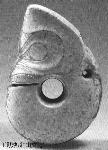 |
A 10 cm wide jade piece called jue 玦 from the Hongshan Culture
紅山文化 in modern Liaoning Province. This piece with a white, opaque color is not
finished because the slit to the middle hole in not
broken through. Used as a talisman, the jue was
worn before the owner's breast on a cord. |
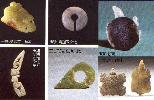 |
Different jade objects from the Neolithic period. |

| The sacrificial weapons made of jade
like axes or this 25 cm long ge 戈
dagger from the Shang period of course have never been
used as real weapons. They were only symbols of the
owner's power. |
 |
A goose, a parrot and a phoenix (about 10 cm long
each) from the late Shang period. This pieces are very
flat (from 2 mm to 7 mm) and are decorated with the same
patterns like the bronze vessels from this time. |
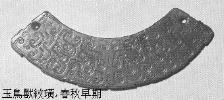 |
A circle-sector jade ornament called huang 璜 from the early Spring and Autumn
period 春秋, 11 cm long, decorated with birds and other
animals. The shape of the animals is very abstract and
seems more to be only a cloud pattern. |
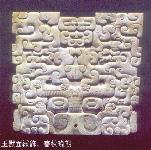 |
The owner of this grey opaque jade plaquette (7 cm
long and high) used it to protect himself. It was
probably worn in front of the breast. The decoration
shows clouds and a monster face from the late Spring and
Autumn period. |
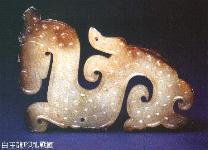 |
A wonderful piece of a jade ornament called pei
珮 (sometimes written with a man
as radical 佩) in the shape of
a dragon from the Warring States period 戰國. |
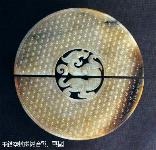 |
This is an unusual example of a bi
璧 jade disk. Most of the bi are
made from white jade and show a hole in the middle of the
piece. This example shows a dragon and is cut in two
pieces (a so-called "combined bi" hebi
合璧 7 cm wide). |
 |
A type of jade piece that is very similar, but more
pierced than the former, is the huan 環, a character that simply means "circle"
in modern Chinese. This is a 9 cm wide piece from the
Western Han Dynasty (Xihan) 西漢. |
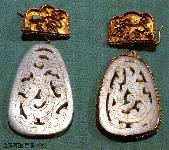 |
Gold and white jade are combined to shape this pair
of earrings from the Xiongnu 匈奴 area during the Western Han
Dynasty. The jade part shows slighty changed Chinese
motifs, while the golden part is clearly nomadic (whole
length 6 cm). |
 |
A white jade seal from a Western Han empress (height
2 cm). The inscription says 皇后之璽 "Seal of the Empress". It was found near the tomb of the Empress Lü
and was probably her own seal. |
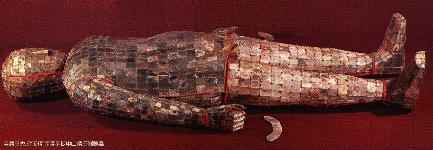 Jade as a heavenly stone was used to demonstrate the
nobility's relationship with the heaven during life and
after death. The dead of the Han dynasty wear clothes
made of jade like this princess. Nine pieces of jade were
used in addition to close the body's nine openings. This is the shroud of Prince Liu Sheng 劉勝, called Prince Jingwang of Zhongshan 中山靖王.
Jade as a heavenly stone was used to demonstrate the
nobility's relationship with the heaven during life and
after death. The dead of the Han dynasty wear clothes
made of jade like this princess. Nine pieces of jade were
used in addition to close the body's nine openings. This is the shroud of Prince Liu Sheng 劉勝, called Prince Jingwang of Zhongshan 中山靖王. |
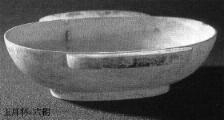 |
From the Han Dynasty on until the 6th century, the
usual drinking vessels had the shape of an oblong bowl
with two narrow handles at both sides, called erbei
耳杯 "ear-bowl". This opaque jade erbei
is from the Six Dynasties period 六朝. |
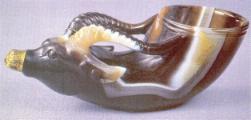 |
This agate rhyton (drinking horn) from the Tang
Dynasty 唐 is clearly not of Chinese origin. |
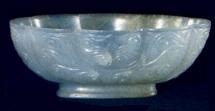 |
A wonderful thin-walled bowl of bluegreen jade from
the Tang Dynasty. |
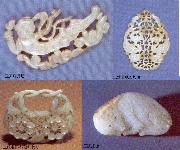 |
From the Tang dynasty on, jade objects had much more
decorating character than the antique sacral objects from
the Shang, Zhou 周 and Han dynasties. Birds, flowers, and
Buddhist elements like the upper left example of a feitian
飛天 fairy became widespread and
could be used to decorate clothing and hair. |
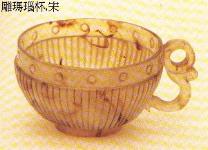 |
The handle of this agate cup from the Song Dynasty 宋 is
not Chinese, at least not in this comination with a cup
that almost looks Western. |
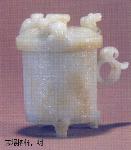 |
A covered cup with three feet and birds on the top
from the Ming Dynasty 明. Similar examples are known from
the Han Dynasty. |
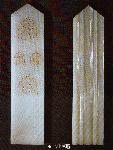 |
This tablet called gui 圭
(sometimes written without the jade radical 珪) was formerly used as a memo tablet.
The jade material makes it a symbol of the owner's rank
during the Ming Dynasty. |
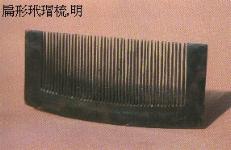 |
A comb made from wonderful emerald green jade from
the Ming Dynasty. |
 |
A brush container from the Ming Dynasty, decorated
with two climbing dragons. The whole object is carved in
an irregular shape following the raw material's surface. |
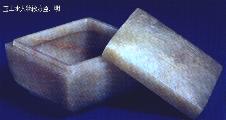 |
Made of bluewhite jade, a quadrangular box from the
Ming Dynasty. |
 |
A Ming Dynasty artist put a white jade bowl on a
golden plate and made it a golden embossed and pierced
cover. |
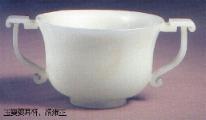 |
Two handles ornate this cup of pure white jade from
the Qing Dynasty 清. |
 |
A small table of cloisonné serves as a stand
for this almost ball-shaped vessel of green jade from the
Qing dynasty. |
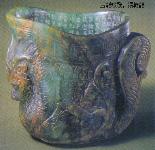 |
An uncovered gong
觥 type vessel of green jade with
brown stains from the Qing dynasty. During the Shang and
Zhou dynasties, the gong was covered and often had the
shape of an animal. This piece has the shape of a dragon
boat and bears - like the antique precursors - an
inscription on the inner side. |
 |
The shape of a gu
觚, a bronze vessel type from the
Shang and Zhou dynasties, served as model for this Qing
dynasty vase, made of emerald green jade. |
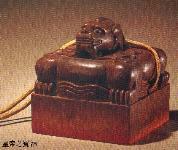 |
A brown jade seal of a Qing Dynasty emperor with the
shape of a reclining lion. |
 |
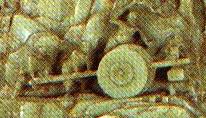 The mythical Emperor Yu 禹 taming the floods and
arranging the nine regions with their different soil qualities is the theme of this
landscape made of a giant jade stone (height with base
244 cm) of green jade, carved during the Qianlong period 乾隆. The mythical Emperor Yu 禹 taming the floods and
arranging the nine regions with their different soil qualities is the theme of this
landscape made of a giant jade stone (height with base
244 cm) of green jade, carved during the Qianlong period 乾隆. |
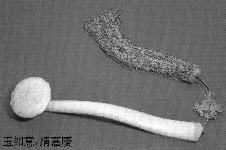 |
A ruyi 如意
scepter of white jade. The shape of the scepter imitates the form of a mythological (phallic) mushroom named Lingzhi that was said
to give eternal life. In Qing times, the ruyi
scepter was used by princes and the emperor as a symbol
of their position. |
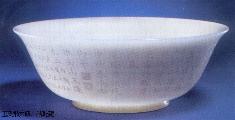 |
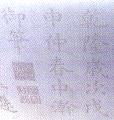 A bowl of pure white jade, decorated with a Qing
Dynasty poem. A bowl of pure white jade, decorated with a Qing
Dynasty poem. |
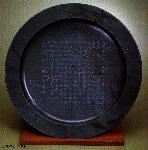 |
Expensive and pure jadeite is the material for this
wonderful dish from the Qing Dynasty, carved with a poem. |
 |
This is the third example of an antique vessel type
copied with a new material. This three legged zun 尊 of yellow jade is ornamented with the
heads of three rams. |
 |
Mountain crystal served as matrial for this double
fish vase from the Qing Dynasty. |